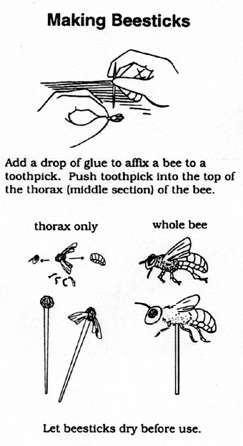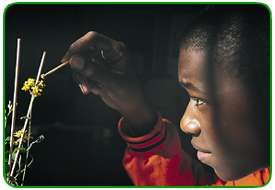| |
Pollinating Fast Plants
Most of the Fast Plants stocks will begin to flower approximately 14-16 days after planting. When flowers on more than two Fast Plants are open, your students should begin to pollinate the flowers. Continue pollinating every day or two among all open flowers for up to 7 days. Pollen of Fast Plants (rapid cycling Brassica rapa) is relatively heavy and sticky. Unlike many grass and some tree pollens, Fast Plants pollen is normally not carried in the air. Therefore, pollinate with beesticks made by gluing a dried bee to the end of a toothpick.

If you don't have dried bees, try using pipe cleaners, cotton swabs, or very small pieces of cloth, (e.g. velveteen) glued to a toothpick. (Students may wish to test the efficiency of different pollination tools with respect to seed yields.)
Pollination

Collect pollen with your beestick from the flowers of one plant and move your beestick to the stigmas of other plants. Be sure to deposit a good load of pollen on the stigma of each flower. Fast Plants are primarily self-incompatible; that is, each stigma prevents pollination from its own pollen.
Terminalize Plants
Discontinue pollination 7 days after the first flowers are open (or sooner if no new flowers appear.) If necessary, pinch off all unopened flower buds at the tip of the stem and on any side shoots.
Water and Fertilizer
Keep the reservoirs full. The plants will need water and fertilizer for another 20-22 days after the last flower is pollinated, so it is important to note the date of the last pollination.
Harvesting and Storing Seed:
Harvesting
20-22 days (or more) after the final pollination, the lower leaves of the plants will wither, and pods will begin to turn yellow. Inside the pods, the seed coats will be turning brown. At this point, remove the nutrient solution or water from the reservoir and allow plants to dry until crispy brown (approximately 1 week).
Harvest each plant carefully by cutting it off at soil level. Take care not to break off the pods. Harvest seeds from each plant separately by gently rolling the dry seed pods between your fingers over a tray. (Alternatively, you can drop seeds onto adhesive tape which is taped to a card with the adhesive side up.)
Storing Seeds
Place the seeds in labeled envelopes. Include: the seed name, e.g. Fast Plants - rapid-cycling Brassica rapa - Basic, the number of plants that produced the seeds, date of harvest, total number of seeds produced, your name, and other pertinent information.
It is important to test the viability of your seed crop by germinating 20-50 seeds on wet paper toweling in a plastic bag or petri dish. Place your germinating seeds under the fluorescent lights or in a bright window sill. After 24 hours, calculate the percentage of germination (or "viability") of your seed. Observe the vigor and uniformity of the germination. Note the germination test date and percent germination on the seed envelope. Typically, a germination rate of is 95% or better is considered to be a successful Fast Plants crop.
For future Fast Plants investigations, store seed envelopes in a cool, dry place, (e.g. in a refrigerator in a moisture-proof, sealed container.) Ideally, the containers sould also contain a drying compound, (e.g., indicator silica gel, which can be obtained from a pharmacist or a camera store.) Seed that is stored in a dry and cool place will remain viable for over 10 years.
|
![]()